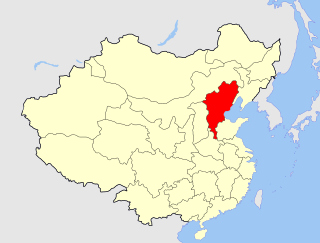Related Research Articles

Yangtze or Yangzi is the longest river in Eurasia and the third-longest in the world. It rises at Jari Hill in the Tanggula Mountains of the Tibetan Plateau and flows 6,300 km (3,915 mi) in a generally easterly direction to the East China Sea. It is the fifth-largest primary river by discharge volume in the world. Its drainage basin comprises one-fifth of the land area of China, and is home to nearly one-third of the country's population.

Nanjing is the capital of Jiangsu province in eastern China. The city, which is located in the southwestern corner of the province, has 11 districts, an administrative area of 6,600 km2 (2,500 sq mi), and as of 2021 a population of 9,423,400. Situated in the Yangtze River Delta region, Nanjing has a prominent place in Chinese history and culture, having served as the capital of various Chinese dynasties, kingdoms and republican governments dating from the 3rd century to 1949, and has thus long been a major center of culture, education, research, politics, economy, transport networks and tourism, being the home to one of the world's largest inland ports. The city is also one of the fifteen sub-provincial cities in the People's Republic of China's administrative structure, enjoying jurisdictional and economic autonomy only slightly less than that of a province. It has also been awarded the title of 2008 Habitat Scroll of Honor of China, Special UN Habitat Scroll of Honor Award and National Civilized City. Nanjing is also considered a Beta city classification, together with Chongqing, Hangzhou and Tianjin by the Globalization and World Cities Research Network, and ranked as one of the world's top 100 cities in the Global Financial Centres Index.

The Grand Canal is a system of interconnected canals linking various major rivers in North and East China, serving as an important waterborne transport infrastructure between the north and the south during Medieval and premodern China. It is the longest artificial waterway in the world and a UNESCO World Heritage Site.

Zhili, alternately romanized as Chihli, was a northern administrative region of China since the 14th century that lasted through the Ming dynasty and Qing dynasty until 1911, when the region was dissolved, converted to a province, and renamed Hebei in 1928.

Zhenjiang, alternately romanized as Chinkiang, is a prefecture-level city in Jiangsu Province, China. It lies on the southern bank of the Yangtze River near its intersection with the Grand Canal. It is opposite Yangzhou and between Nanjing and Changzhou. Zhenjiang was formerly the provincial capital of Jiangsu and remains as an important transportation hub. As of the 2020 census, its total population was 3,210,418 inhabitants whom 1,266,790 lived in the built-up area made of the 3 urban districts. The town is best known both in China and abroad for Chinkiang vinegar, a fragrant black vinegar that is a staple of Chinese cooking.

Jiangnan is a geographic area in China referring to lands immediately to the south of the lower reaches of the Yangtze River, including the southern part of its delta. The region encompasses the city of Shanghai, the southern part of Jiangsu Province, the southeastern part of Anhui Province, the northern part of Jiangxi Province and Zhejiang Province. The most important cities in the area include Anqing, Changzhou, Hangzhou, Nanjing, Ningbo, Shaoxing, Suzhou, Wuxi, Wenzhou, Yangzhou and Zhenjiang.

The Yangtze Delta or Yangtze River Delta, once known as the Shanghai Economic Zone, is a megalopolis generally comprising the Wu-speaking areas of Shanghai, southern Jiangsu, northern Zhejiang, southern Anhui. The area lies in the heart of the Jiangnan region, where the Yangtze drains into the East China Sea. Historically the fertile delta fed much of China’s population, and cities and commerce flourished. Today, it is one of China’s most important metropolitan area and is home to China’s financial center, tourist destination and hub for manufacture ranging from textile to car-making. In 2021, the Yangtze Delta had a GDP of approximately US$4.3 trillion, about the same size as Japan.

Hankou, alternately romanized as Hankow, was one of the three towns merged to become modern-day Wuhan city, the capital of the Hubei province, China. It stands north of the Han and Yangtze Rivers where the Han flows into the Yangtze. Hankou is connected by bridges to its triplet sister towns Hanyang and Wuchang.

Wuhu is a prefecture-level city in southeastern Anhui province, China. Sitting on the southeast bank of the Yangtze River, Wuhu borders Xuancheng to the southeast, Chizhou and Tongling to the southwest, Hefei City to the northwest, Ma'anshan city to the northeast, Jiangsu to the east, and is approximately 90 km (56 mi) southwest of Nanjing. With the urbanization trend in the southern part of Nanjing, a conurbation between Nanjing, Maanshan and Wuhu is in building with more than 10,660,000 inhabitants.
The 1642 Yellow River flood or Kaifeng flood was a man-made disaster in October, 1642, that principally affected Kaifeng and Xuzhou.

Qixia District is one of 11 districts of Nanjing, the capital of Jiangsu province, China, straddling both sides of the Yangtze River.

Zhang Shicheng, born Zhang Jiusi (張九四), was one of the leaders of the Red Turban Rebellion in the late Yuan dynasty of China.

Lower Yangtze Mandarin is one of the most divergent and least mutually-intelligible of the Mandarin languages, as it neighbours the Wu, Hui, and Gan groups of Sinitic languages. It is also known as Jiang–Huai Mandarin, named after the Yangtze (Jiang) and Huai Rivers. Lower Yangtze is distinguished from most other Mandarin varieties by the retention of a final glottal stop in words that ended in a stop consonant in Middle Chinese.

The Qinhuai River is a tributary of the Yangtze with a total length of 110 km. It flows through central Nanjing and is called "Nanjing's mother river". It is the "life blood" of the city. The Qinhuai River is divided into inner and outer rivers.

Mochou Lake is located west of the Qinhuai River and Hanzhongmen Gate in Nanjing, inside Mochou Lake Park. The lake is named after Mochou, a legendary woman known for her beauty, versatility, virtue and loyalty. It was named Hengtang in ancient times, and also known as Stone City Lake. The lake park was owned by Zhu Yuanzhang, the first emperor of Ming dynasty, and bestowed to his general Xu Da. Since then, it has become a famous garden best known for its two-storied Shenggi Pavilion. Within the park are other pavilions, gardens, pools and a stunning rock display. It is noted for its architecture, collection of carved antique rosewood furniture and calligraphies. Visitors can take boats allow through the lotus blossomed lake.
The 1416 Yellow River flood was a natural disaster affecting the area around Kaifeng, China, during the early Ming dynasty. The flood spilled over into fourteen other counties and seriously disturbed the Huai River.
Yangzhou, Yangchow or Yang Province was one of the Nine Provinces of ancient China mentioned in historical texts such as the Tribute of Yu, Erya and Rites of Zhou.
The following is a timeline of the history of the city of Nanjing, Jiangsu Province, China.
Shangxinhe is a former town in the Jianye District of Nanjing, China located on the Jia River (夹江), a tributary of the Yangtze River. The former Wang Hanzhou residence, Jianghan Hall (江汉会馆), Ancient Sun Palace (古太阳宫), and other ancient cultural sites are located in the area.

Jiangnan, formerly romanized as Kiangnan, was a historical province of the early Qing dynasty of China. Its capital was Jiangning, from which it is sometimes known as Nanjing or Nanking Province. Established in 1645 during the Qing conquest of Ming, it administered the area of the earlier Ming province of Nanzhili, reaching from north of the Huai River—at the time the course of the Yellow River—to south of the Yangtze River in East China. Its territory was later divided into the separate provinces of Jiangsu and Anhui during the reign of the Qianlong Emperor (1736–1795), although the exact timing is disputed, with Jean-Baptiste Bourguignon d'Anville's map of 1734 showing the province still extant as "Kiang-nan". The earliest that the province's partition could have happened was 1667. Under the Republic and People's Republic of China, an area of Jiangsu also became the provincial-level municipality of Shanghai.
References
- ↑ Tsai, Shih-Shan Henry.SUNY Series in Chinese Local Studies: The Eunuchs in the Ming Dynasty . SUNY Press, 1996. ISBN 0791426874, 9r780791426876. Accessed 16 Oct 2012.